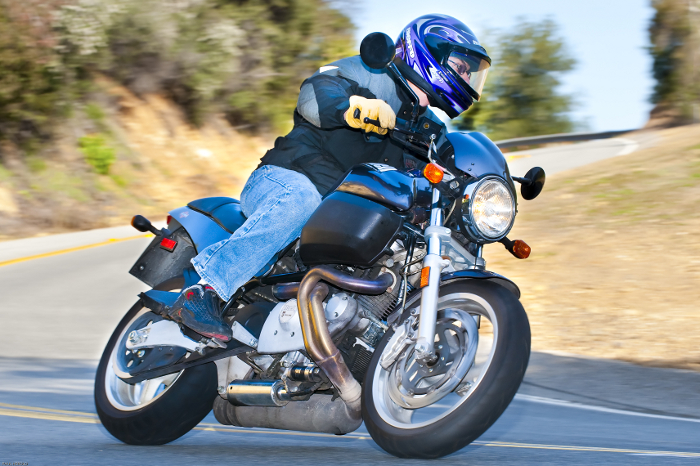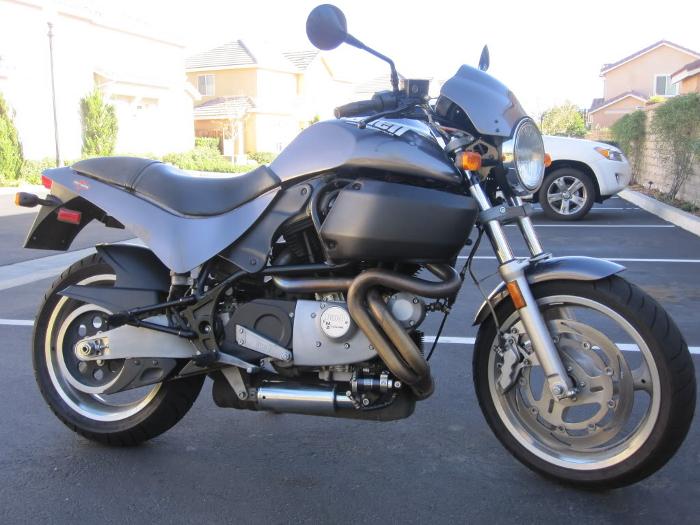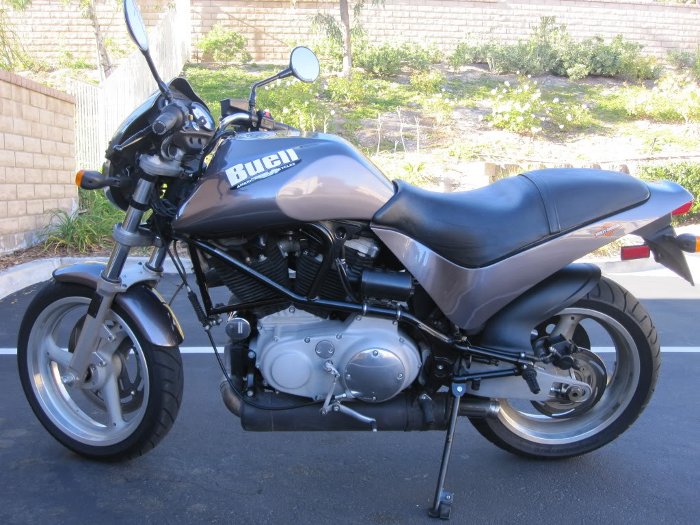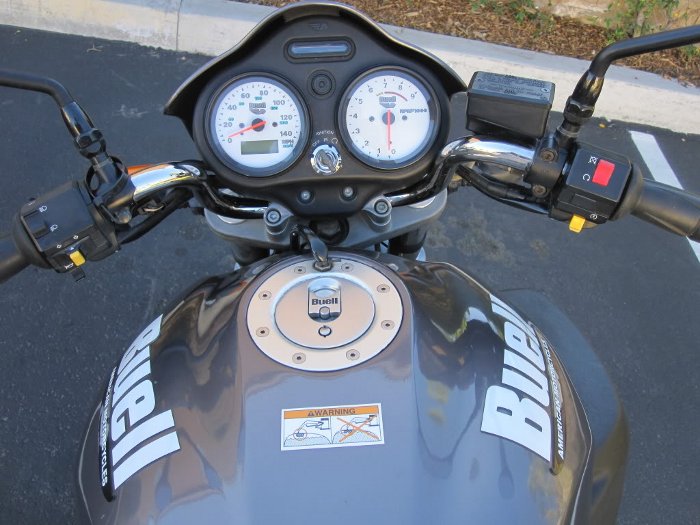|
Home Page Suzuki GS650G Information Harley-Davidson Sportster Kawasaki ZRX1200 BSA Lightning Info Moto-Guzzi V1000 Convert Honda XL500R Royal Enfield Bullet Harley-Davidson FXR About |
|
|
2001 Buell Cyclone
The Buell M2 Cyclone is my favorite Buell Motorcycle. I bought this 2001 Buell Cyclone in 2010 soon after I found out the Buell Motorcycle Company had been shut down by its corporate parent, Harley-Davidson. First, a little info on what a Buell motorcycle is and why they've stopped making them, and then the story of my bike and what you should look for if you want to buy a Buell M2 Cyclone. Erik Buell was an engineer at Harley-Davidson from 1979 to 1982, where he worked a number of things, including the FXR frame, which some people consider the best Harley-Davidson Big Twin ever because of its sturdy, great-handling frame. (See my FXLR Low Rider Here) Erik Buell went into business for himself, developing race motorcycles based on the 750cc square-four two-stroke Barton engine. Eventually, Buell made a deal with Harley-Davidson to manufacture sportbikes based on Harley-Davidson engines, and the Sportster-engined Buells were born. Buell motorcycles were somewhat of an oddity in the motorcycle market, as they did a lot of things very well, but couldn't match the power of the Japanese superbikes. The Harley guys didn't want them because they weren't cruisers, and the sportbike riders didn't want them because they weren't powerful enough. Erik Buell was well aware of this and did the best he could under the circumstances for over 20 years before he finally got Harley-Davidson to agree to let him use a non-Harley engine in Buell Motorcycles. The result was the Buell 1125R, which won the AMA Daytona SportBike Championship in 2009, soon after which Harley-Davidson shut Buell Motorcycles down altogether and auctioned everything off. It's really sad that Erik Buell finally got to build the bike he had dreamed of for 25 years, and they put him out of business. I suppose you could blame consumer demand and the recession as much as Harley-Davidson, but it's a sad story no matter who you blame. Erik Buell formed Erik Buell Racing in 2009, which produces race-only versions of the Buell 1125R motorcycle as well as parts for the bikes. From the beginning, Erik Buell established 3 design philosophies,
which are evident in all of his motorcycles. They are: Here's a video I made to show what's good about the Buell M2 Cyclone motorcycle. Read on below the video to learn more specific detalis about this bike. I test-drove a 1200-Sportster-engined Buell in 1996 and thought it was a neat bike to ride, but it felt underpowered compared to the Suzuki GS1000 I was used to. In 1996, the Buell was running a stock 1200 Sportster engine, with a more efficient intake and exhaust system, evident in the big ugly air cleaner (I actually like it and am keeping it on the bike) and the huge muffler. I had recently purchased an 883 Sportster for commuting, so I wasn't in the market for a new bike anyway. Years went by, life got more complicated, and I bought and sold a lot of different motorcycles (Links to most of them are at the top of this page under the ads). 14 years go by, I'm over 40, and I'm thinking about getting a comfortable sporty standard motorcycle. Maybe a Ducati Monster or Triumph Speed Triple. All of my other bikes are fun to ride fast, but none of them are particularly good at it. I test drove a Buell XB1200 at Bartels Harley-Davidson, but I'm 6 foot 1, and the riding position was way too awkward and uncomfortable for my body because the XB12 is such a small motorcycle. Then I hear that Buell Motorcycles has gone out of business, and that dealers are giving bikes away. Because I don't fit on the newer Buells (Except maybe the Ulysses), and I love the old Evolution Sportster engines because they are reliable, super-low-maintenance, and easy to work on, and I know engine parts will be cheap and easy to find if something breaks, I decide to look for a tube-frame Buell. I ended up buying the first one I looked at, a 2001 M2 Cyclone in mostly-stock condition with 15,000 miles on it for $2,800, which is a lot cheaper than a similar-condition Ducati or Triumph. In my opinion, the Cyclone is the best Buell motorcycle. Of course, by that I mean it's best for my body and the kind of riding I like to do. Why? The tube-framed Buell motorcycles like mine were produced from 1997-2002. It's best to get the newest one possible, 2000 or later to get the best engine. Mine is a 2001 Buell M2 Cyclone. 2000 and earlier Cyclones didn't come with a tachometer, and there were some motor mount recalls on early models as well. Buell offered 3 different styles of Sportster-powered bikes during this time. The S1 Lightning was the sporty hooligan Buell, with a tiny seat, high foot pegs and a really sparse look. I think it is the best-looking of the tubers. The S3 and S3T Buell Thunderbolt was the sport-touring model, with a fairing and optional hard saddlebags. It was heavier than the others, and built for touring. In the middle of the lineup, between sporty and touring was the Buell M2 Cyclone. It was a naked model, with a little tiny fairing, no luggage, and the most comfortable motorcycle seat I've ever sat on. Here's what I like about it... I should preface this by saying some folks refer to the Cyclone as "The Old Man's Sportbike." The Buell M2 Cyclone has ergonomics perfect for commuting and long days riding in the canyons without causing neck, back, butt and wrist pain at the end of the day. The seat is wide and just the right softness to ride all day long. The foot pegs are lower than the Lightning's so my knees are in a comfortable bend. The handlebars are high enough to be comfortable, with a slight forward lean. In short, the riding position is classic sport-standard style, which is what I grew up riding. Now on to the technical details. My Buell M2 Cyclone has a carbureted Thunderstorm 1200 Sportster engine, which makes 91 HP at 6000 RPM and 85 ft/lbs of torque at 4900 RPM. Those are the factory figures. Actual numbers are probably a little lower. The 2000-2002 Buell Cyclone engines are more powerful and quicker-revving than previous year models due to the Thunderstorm heads (added in 1999) and the lightened flywheel (added in 2000). The Thunderstorm Sportster engine uses the stock 1200 Sportster cam, so a person could pep it up with a bigger cam. One thing I love about Harley-Davidson engines is the low maintenance and reliability. For example, what's the valve adjustment interval on your motorcycle, and how much does it cost? On the Evolution Sportster and Big Twin engines, you never have to adjust the valves because they use automatic hydraulic lifters. You just change the oil and check the primary chain adjustment every 5,000 miles. Click here to go to my instructional page on how to adjust the primary chain on a Harley-Davidson motorcycle engine. If you don't like adjusting the primary chain, you can install an automatic primary chain adjuster. Harley-Davidson makes a Screamin' Eagle automatic primary chain adjuster, or you can go with a Hayden M6 primary chain adjuster. It's easy enough to adjust on the primary on a Sportster engine, so I use the stock adjuster on mine. Another low-maintenance item is the Kevlar final drive belt. My 883 Sportster had 43,000 miles on its belt when I sold it, and it was working fine. I've heard they can go 100,000 miles. That's much better than a chain, and lighter and lower maintenance than a driveshaft. Calculate what it would cost to maintain the Buell over 100,000 miles, and compare it to a Ducati Monster (Desmo valve belts, chains, sprockets, etc.), and you'll see why I like the Buell. The Buell M2 Cyclone has a dry weight of 435 pounds, and that weight is as low and central as possible, helped out by the narrowness of the top end of the Sportster engine and the placement of the muffler and rear shock absorber and spring underneath the engine. Wheelbase is 55 inches, and the Cyclone handles like a sporty standard motorcycle, very stable in the turns, and plenty of power across the power band, so there's no need to rev it high. It definitely feels bigger than the newer XB12 Buells, which is a good thing for me. I like a bike that can handle twisty roads and is also reasonably comfortable and stable on the freeway. The M2 Cyclone has a 5-gallon gas tank, which I think is great. If he wanted to make the bike lighter to impress motojournalists and test riders, he could have put a much smaller tank on it, but this bike was designed to work in the real world, and 5 gallons of gas in the tank means you can go 180 to 200 miles between fill-ups, which is great. In all-around commuting riding, I get 40 miles per gallon. It goes onto reserve after 3.3 gallons have been used. The engine rubber-mounting system works great at speeds above 2,500 RPM, and the Buell M2 Cyclone is has less vibration on the freeway than a big Japanese four. It is completely smooth. Front and rear suspension are adjustable to suit your riding style. Front shocks are adjustable for preload and rebound damping. Rear shock is adjustable for preload and compression damping. This bike does everything well, and it is usually my first choice when I'm deciding which one of my bikes to ride, no matter where I'm going. I like it just the way it is and don't plan to do any hot-rodding of the engine or changes to the look of the bike. Here are a few more pictures of my Buell M2 Cyclone motorcycle.
|
|



